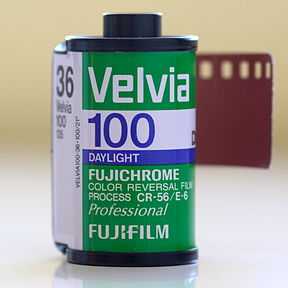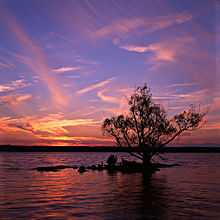Velvia
| Velvia (RVP) | |
 | |
| Maker: | Fujifilm |
| Speed: | ISO 50/18° |
| Type: | Color slide |
| Balance: | Daylight |
| Process: | E-6 |
| Format: | 35mm, 120, 220, 4×5 in, 8×10 in, 13×18 cm, Super 8†, 16mm† †Third party |
| Grain: | RMS 9 |
| Exposure latitude: |
±½ stop |
| Saturation: | very high |
| Application: | Nature |
| Introduced: | 1990 |
| Discontinued: | 2005[1] |
| Velvia 50 (Velvia II) (RVP50) | |
| Maker: | Fujifilm |
| Speed: | ISO 50/18° |
| Type: | Color slide |
| Balance: | Daylight |
| Process: | E-6 |
| Format: | 35mm, 120, 220, 4×5 in*, 8×10 in*, QuickLoad 4×5 in* *Discontinued [2][3] |
| Grain: | RMS 9 |
| Exposure latitude: |
±½ stop |
| Saturation: | very high |
| Application: | Nature |
| Introduced: | 2007 |
| Velvia 100 (RVP 100) | |
 Fuji Velvia 100 film cartridge | |
| Speed: | ISO 100/21° |
| Format: | 35mm, 120, 220, 4×5 in, 8×10 in |
| Grain: | RMS 8 |
| Exposure latitude: |
±½ stop |
| Saturation: | very high |
| Application: | Nature |
| Introduced: | 2005 |
| Velvia 100F (RVP 100F) | |
| Speed: | ISO 100/21° |
| Format: | 35mm, 120, 220, 4×5 in, 8×10 in, 9×12 cm, 13×18 cm |
| Grain: | RMS 8 |
| Exposure latitude: |
±½ stop |
| Saturation: | high |
| Application: | Nature |
| Introduced: | 2002 |
| Discontinued: | 2012[1] |
Velvia is a brand of daylight-balanced color reversal film produced by the Japanese company Fujifilm. The name is a contraction of "Velvet Media", a reference to its smooth image structure. The original incarnation of the film was called "Velvia for Professionals", known as RVP, a classification code meaning "Reversal/Velvia/Professional series." It is known for its extremely high level of color saturation and image quality.
Velvia (RVP) was introduced in 1990[citation needed] and quickly became a "must try" film, giving Kodachrome 25 some stiff competition as the industry standard in high-definition color film.[citation needed] It has brighter and generally more accurate color reproduction (though many see its high color saturation as unrealistic), finer grain, twice the speed, and a more convenient process (E-6). Kodachrome 25 fell out of popularity a few years after Velvia was introduced (in part because of Kodak's lack of interest in promoting their film); Kodachrome 64 and 200 followed more slowly. Kodachrome 25 had previously been considered the film to which all other films had been compared, and cannot fairly be compared to Velvia, as Kodachrome is an entirely different process, in which the image is produced with "color clouds" more so than grain.
Velvia has the highest resolving power of any slide film.[4][5] A 35 mm Velvia slide can resolve up to 160 lines per mm.[6]
Appearance
-

Sunset over the St. Lawrence River, shot on 6x6 cm Velvia 50
-

A photo taken with Fuji Velvia 50 film
Velvia has very saturated colors under daylight, high contrast, and exceptional sharpness. These characteristics make it the slide film of choice for many nature photographers, including such respected artists as Rodney Lough Jr., Steve Parish, Peter Lik, and the late Galen Rowell.
Shaw, who is known for his extreme close-ups of flowers, has praised the film for its accurate reproduction of the color purple, which has been a difficult color to accurately capture on other films. This was a major issue with Kodachrome, which tended to render purple objects as blue.
Speeds
The original Velvia (RVP) was an ISO 50 film. In practice, many photographers used an exposure index (EI) of 40 or 32 to over-expose it slightly (one or two thirds of a stop respectively) in order to yield less saturated colors and more shadow detail.[citation needed] It was discontinued in 2005.
Velvia 50 (RVP50) was reintroduced, on the new film base, in 2007 after announcements under the provisional name Velvia II in 2006. The original Velvia (RVP) had been discontinued because of difficulties in obtaining some of the raw materials needed to make the emulsion. Fuji R&D created a new emulsion which substituted different materials in its manufacture yet retained the appearance of the classic Velvia.[7]
Velvia 100F (RVP 100F) offers saturated colors, better color fidelity and higher contrast. It was introduced in 2002[8] and discontinued in 2012 although stocks are still available.[9][10] Velvia 100F is less saturated than RVP50 and is accurate in color rendition with the exception of yellow. It exaggerates this color, especially when there is a slight yellowish cast in the scene. On film, this will be a deeper and more noticeable yellow.
Velvia 100 (RVP 100) is about as saturated as the original version (RVP) but has lower contrast.[citation needed] The newer speed also has finer grain (an RMS granularity value of 8), and uses the color correction layers found in Provia 100F. Velvia 100 (RVP 100) was introduced in 2005, to replace the discontinued original Velvia (RVP).[1] The color rendition of Velvia 100 seems to favor the red end of the spectrum. Beige will be seen as more reddish. Blues and greens are rendered very well. Reds are especially vibrant.
Long exposure problems
The original Velvia (RVP) suffered much more from reciprocity failure than other films. Exposing the film for as little as 16 seconds produced a color shift, typically to purple or green, depending on shooting conditions. Anything over four seconds requires the use of magenta color correction filters if correct color balance is required, and anything over 32 seconds is "not recommended" by Fuji.[citation needed]
Velvia 100 (RVP 100) is much better with long exposures: no reciprocity failure compensation is required for exposures shorter than 1 minute.[11]
Velvia in cinematography
Velvia film stock was available through 2006 [citation needed], and has since been replaced by the Eterna series of film stock. Velvia was used for many commercials, but rarely for feature films. Its main use in movies was for shooting stock landscape shots and special-effects background plates. One example is the 1998 film What Dreams May Come, which took place largely within a painting. The closest replacement for the original Velvia film stock is Eterna Vivid 160, which produces roughly the same color effect and is more easily processed.
Since 2006, Velvia 50 D (also sold as Cinevia) is available in Super 8 via three independent companies, Pro8mm in the US, and GK Film and Wittner Kinotechnik in Europe. However, demand for it is higher than those companies together are currently capable of properly supplying. Spectra Film and Video has also been loading Fuji Velvia into Super 8 cartridges and for 16 mm. They recently modified the Kodak-supplied cartridges to ensure a smoother transport of Velvia film through the cartridge.
References
- ↑ 1.0 1.1 1.2 "Fuji Velvia 50". Retrieved 2009-03-25.
- ↑ http://www.bjp-online.com/british-journal-of-photography/news/2193030/fujifilm-discontinues-two-professional-films
- ↑ http://www.talkphotography.co.uk/forums/showpost.php?p=5681160&postcount=24
- ↑ http://www.fujifilm.com/products/professional_films/pdf/velvia_50_datasheet.pdf
- ↑ "The Green Signature Darkroom". Thegreensignature.com. Retrieved 2013-02-04.
- ↑ "FUJICHROME Velvia for Professionals (RVP)" (PDF). Fujifilm. February 25, 2004. Archived from the original on 2007-09-27. Retrieved 2007-06-10.
- ↑ "FUJICHROME Velvia 50 Professional (RVP50)" (PDF). Fujifilm. Retrieved 2009-03-25.
- ↑ "FUJICHROME Velvia 50 Professional". Retrieved 2011-01-17.
- ↑ http://www.bjp-online.com/british-journal-of-photography/news/2193030/fujifilm-discontinues-two-professional-films
- ↑ http://www.talkphotography.co.uk/forums/showpost.php?p=5681160&postcount=24
- ↑ "FUJICHROME Velvia 100 Professional (RVP 100)". Fujifilm. Retrieved 2011-01-04.
External links
![]() Media related to Velvia at Wikimedia Commons
Media related to Velvia at Wikimedia Commons
- Fujichrome products page
- super8camera.com for Velvia samples & other super-8 stock.